Granada
 A-4: Autopista del Sur(via Madrid-Granada). There is nothing better to do while in a roadtrip than stopping to enjoy some great local food. The blue car shown in the picture took us from Madrid to Granada and Sevilla.
A-4: Autopista del Sur(via Madrid-Granada). There is nothing better to do while in a roadtrip than stopping to enjoy some great local food. The blue car shown in the picture took us from Madrid to Granada and Sevilla.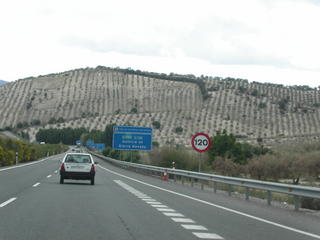 Andalusia's farming consists of olive plantations. The Andalusia region produces over 70% of Spain's total olive oil production.
Andalusia's farming consists of olive plantations. The Andalusia region produces over 70% of Spain's total olive oil production.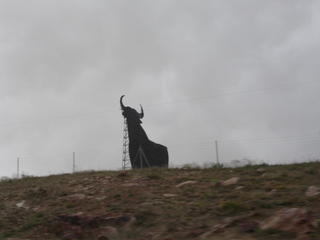 A familiar sight alongside Spanish Autopistas.
A familiar sight alongside Spanish Autopistas. Granada is located on one of the foothills of the Sierra Nevada Mountain range and was a stronghold of the Nazeri Dynasty, the last great Moorish kingdom in Spain. On leaving Spain the Arabs had to leave behind one of the most fabulous medieval palaces ever built, the Alhambra of Granada.
Granada is located on one of the foothills of the Sierra Nevada Mountain range and was a stronghold of the Nazeri Dynasty, the last great Moorish kingdom in Spain. On leaving Spain the Arabs had to leave behind one of the most fabulous medieval palaces ever built, the Alhambra of Granada.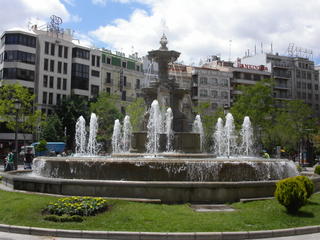 Fountain at Plaza Campillo in Granada's Centre.
Fountain at Plaza Campillo in Granada's Centre.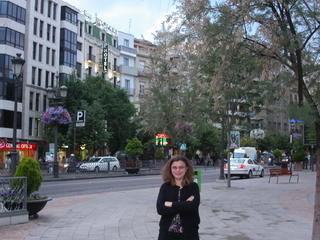 The charming Hotel Juan Miguel is located in the city centre of Granada. We stayed at this hotel for 3 nights, and we really enjoyed it. The Hotel Juan Miguel is close to the Cathedral, the Congress Palace, and the city’s finest shops.
The charming Hotel Juan Miguel is located in the city centre of Granada. We stayed at this hotel for 3 nights, and we really enjoyed it. The Hotel Juan Miguel is close to the Cathedral, the Congress Palace, and the city’s finest shops.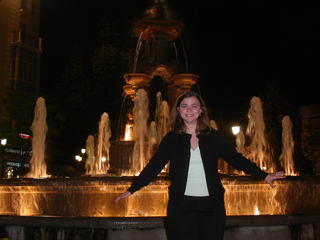 Sara in front of Plaza Campillo's fountain(across the street from our hotel).
Sara in front of Plaza Campillo's fountain(across the street from our hotel).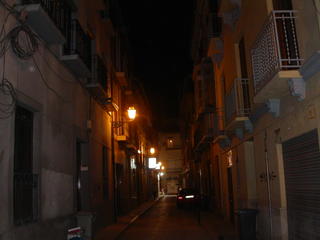 Calle San Anton in Granada. This street is located behind the Don Juan Miguel Hotel.
Calle San Anton in Granada. This street is located behind the Don Juan Miguel Hotel.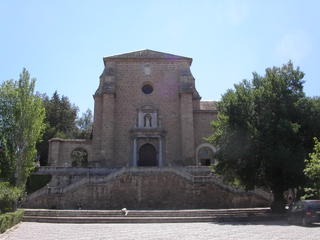 Monasterio Cartuja: This 16th-century monastery, off the Albaicín on the outskirts of Granada, is sometimes called the "Christian answer to the Alhambra" because of its ornate stucco and marble and the baroque Churrigueresque fantasy in the sacristy.
Monasterio Cartuja: This 16th-century monastery, off the Albaicín on the outskirts of Granada, is sometimes called the "Christian answer to the Alhambra" because of its ornate stucco and marble and the baroque Churrigueresque fantasy in the sacristy.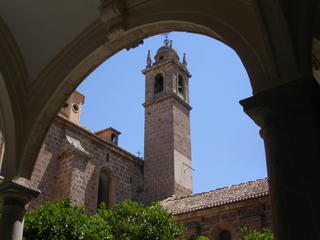 Napoléon's armies killed St. Bruno here, and La Cartuja is said to be the only monument of its kind in the world.
Napoléon's armies killed St. Bruno here, and La Cartuja is said to be the only monument of its kind in the world. Oscar taking a breather in the very nice Gardens inside El Monasterio La Cartuja.
Oscar taking a breather in the very nice Gardens inside El Monasterio La Cartuja.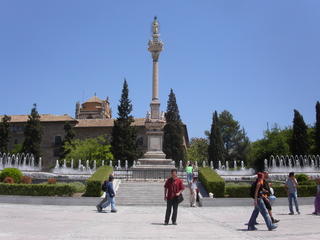 Jardines Triunfo: During the Napoleon invasion of Granada at the beginning of the eighteen century, this site was utilized to executive prisioners. In 1831, Mariana Pineda, whom fought for the freedom of her people, was executed here by Napoleon's troops. The monument behind Oscar was built to commemorate her death.
Jardines Triunfo: During the Napoleon invasion of Granada at the beginning of the eighteen century, this site was utilized to executive prisioners. In 1831, Mariana Pineda, whom fought for the freedom of her people, was executed here by Napoleon's troops. The monument behind Oscar was built to commemorate her death.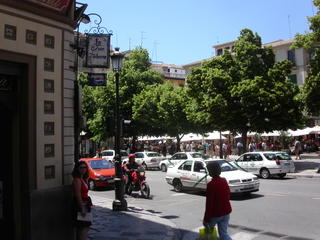 Plaza Nueva(New Square): Despite its name, the oldest square is the Plaza Nueva. The square was built to cover up the River Darro which flows underneath in order to create more space in the city.
Plaza Nueva(New Square): Despite its name, the oldest square is the Plaza Nueva. The square was built to cover up the River Darro which flows underneath in order to create more space in the city.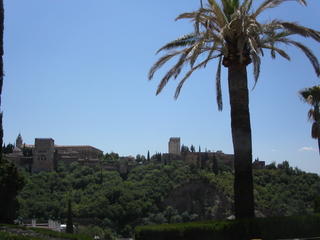 Vie of the east wall of La Alahambra from the Alabaicin. The Albaicín is the old Arabic quarter located on the hill opposite the Alhambra.
Vie of the east wall of La Alahambra from the Alabaicin. The Albaicín is the old Arabic quarter located on the hill opposite the Alhambra. The Albaicín is characterised by cobble stoned streets with white washed houses. It still retains a a strong Arabic feeling.
The Albaicín is characterised by cobble stoned streets with white washed houses. It still retains a a strong Arabic feeling.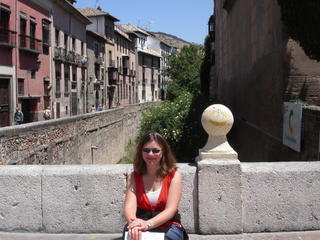 Carrera del Barro is the most-walked street in Granada. This little road is sandwiched between the Darro River and the Albaicin. The old bridges and remains of Arabic archways make it really pretty.
Carrera del Barro is the most-walked street in Granada. This little road is sandwiched between the Darro River and the Albaicin. The old bridges and remains of Arabic archways make it really pretty.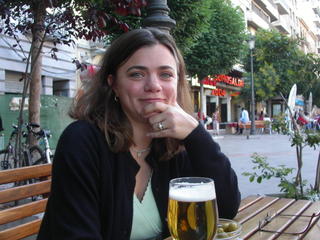 After a long day of sightseeing, we stopped at one of the many coffee shops on Acera del Darro to have a drink.
After a long day of sightseeing, we stopped at one of the many coffee shops on Acera del Darro to have a drink.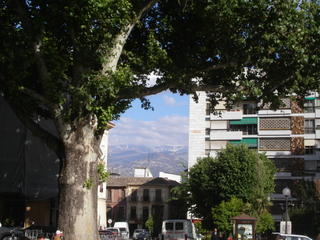 On the background, you can see Sierra Nevada considered the best place to ski in Spain. Sierra Nevada is Spain's highest mountain range
On the background, you can see Sierra Nevada considered the best place to ski in Spain. Sierra Nevada is Spain's highest mountain range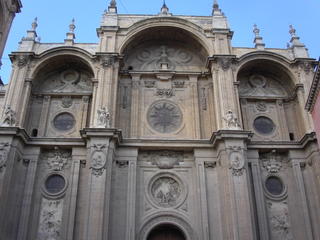 La Catedral de Granada: like many other Cathedrals in Spain, it was built on the site of the former Mosque. Work on the cathedral began on 15th March 1523 and it was not completed until 1704, 180 years later.
La Catedral de Granada: like many other Cathedrals in Spain, it was built on the site of the former Mosque. Work on the cathedral began on 15th March 1523 and it was not completed until 1704, 180 years later.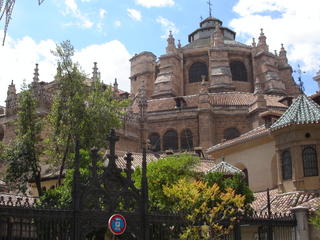 La Catedral de Granada: This was the last gothic church to be built in Spain as Isabel and Fernando did not like the new renaissance style of the time.
La Catedral de Granada: This was the last gothic church to be built in Spain as Isabel and Fernando did not like the new renaissance style of the time.  La Capilla Real: Royal Chapel is connected to the Cathedral. It was commisioned by the Catholic Monarchs, Queen Isabel and King Fernando whom are buried here alongside their daughter Queen Juana La Loca (Juana the Mad) and King Felipe. The original idea was for all future Spanish Kings and Queens to be buried here.
La Capilla Real: Royal Chapel is connected to the Cathedral. It was commisioned by the Catholic Monarchs, Queen Isabel and King Fernando whom are buried here alongside their daughter Queen Juana La Loca (Juana the Mad) and King Felipe. The original idea was for all future Spanish Kings and Queens to be buried here.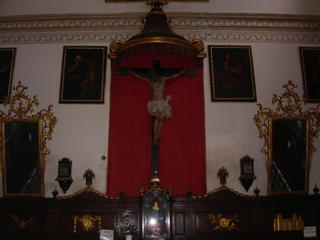 La Sacristia (the Sacristy): In the sacristy, you can see a figure of Christ by Martinez Montañes, an Annunciation and a valued image of the Virgin Mary by Alonso Cano.
La Sacristia (the Sacristy): In the sacristy, you can see a figure of Christ by Martinez Montañes, an Annunciation and a valued image of the Virgin Mary by Alonso Cano. La Cupula (dome): The dome is adorned with stained glass windows. During the day, the dome radiates a golden light making it even more impressive.
La Cupula (dome): The dome is adorned with stained glass windows. During the day, the dome radiates a golden light making it even more impressive.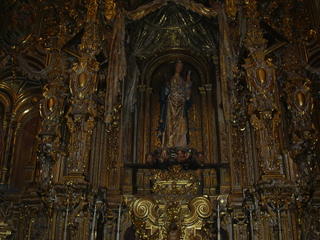 This is one of the many Capillas (chapels) in the Cathedral honoring different Spanish and regional saints and virgins.
This is one of the many Capillas (chapels) in the Cathedral honoring different Spanish and regional saints and virgins.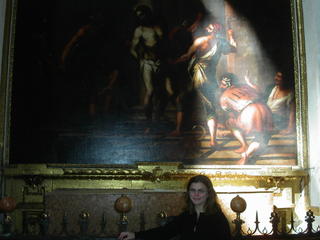 Throught the Cathedral, Sacristy and the Royal Chapel, you can see works by Roger Van der Weyden and various Spanish and Italian masters as Botticelli.
Throught the Cathedral, Sacristy and the Royal Chapel, you can see works by Roger Van der Weyden and various Spanish and Italian masters as Botticelli.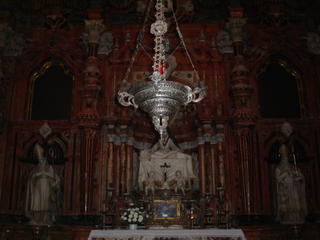 Some Chapels are utilized for prayer or to conduct mass.
Some Chapels are utilized for prayer or to conduct mass.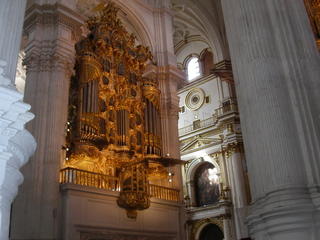 The Cathedral is acclaimed for its beautiful facade and gold-and-white interior.
The Cathedral is acclaimed for its beautiful facade and gold-and-white interior.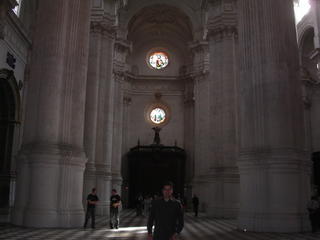 It’s difficult to comprehend the enormity of this building until you step inside.
It’s difficult to comprehend the enormity of this building until you step inside.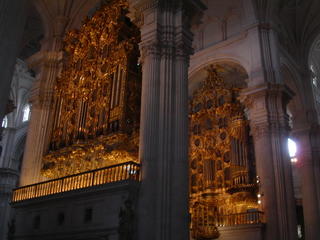 We consider La Catedral de Granada the most beautiful Cathedral that we have seen so far. Notre Dame in Paris is amazing, but La Catedral de Granada is truly a wonder.
We consider La Catedral de Granada the most beautiful Cathedral that we have seen so far. Notre Dame in Paris is amazing, but La Catedral de Granada is truly a wonder.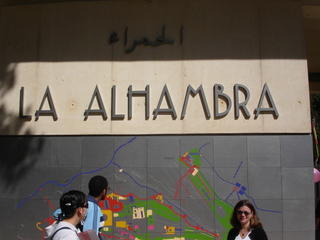 La Alhambra: The name Alhambra means "the red one" and refers to the color of the mountain on which it is built. After having been built in the 9th century by the Zyridian rulers and later into a fortress in the 11th century, the Nasrid King Ibn al-Ahmar reconstructed what had been left, adding outer walls and innumerous towers, being completed in 1238.
La Alhambra: The name Alhambra means "the red one" and refers to the color of the mountain on which it is built. After having been built in the 9th century by the Zyridian rulers and later into a fortress in the 11th century, the Nasrid King Ibn al-Ahmar reconstructed what had been left, adding outer walls and innumerous towers, being completed in 1238.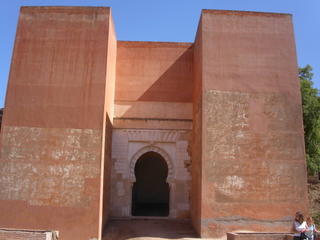 Tower of the Seven Floors (la Torre de los Siete Suelos): It is famous in the neighborhood as the scene of strange apparitions and Moorish enchantments. La Puerta de los Siete Suelos is so called because it was originally protected by a larger external gate which had seven "steps".
Tower of the Seven Floors (la Torre de los Siete Suelos): It is famous in the neighborhood as the scene of strange apparitions and Moorish enchantments. La Puerta de los Siete Suelos is so called because it was originally protected by a larger external gate which had seven "steps".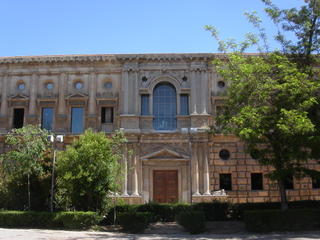 Palacio de Carlos V: Emperor Charles V began the construction of the palace in 1526 but never finished; it perhaps seems more out of place than any other building in theAlhambra.
Palacio de Carlos V: Emperor Charles V began the construction of the palace in 1526 but never finished; it perhaps seems more out of place than any other building in theAlhambra.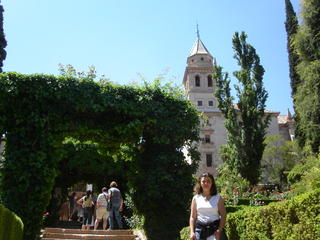 There are numerous gardens with maze-like hedges, various topiaries, and running water flowing throughout. It's truly a magical place.
There are numerous gardens with maze-like hedges, various topiaries, and running water flowing throughout. It's truly a magical place.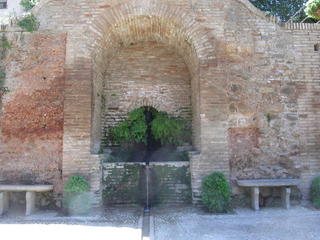 Water fountains were built in all over the Alhambra with interesting small canals that provided the water necessary to irrigate the gardens and for the community living in the palace.
Water fountains were built in all over the Alhambra with interesting small canals that provided the water necessary to irrigate the gardens and for the community living in the palace.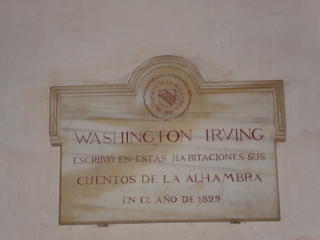 In the early 1820's, American writer Washington Irving lived in La Alhambra. He made the Alhambra popular with his famous novel "Tales of the Alhambra" after it had fallen into ruins and had been used by gypsies, vagabonds and even as a prison.
In the early 1820's, American writer Washington Irving lived in La Alhambra. He made the Alhambra popular with his famous novel "Tales of the Alhambra" after it had fallen into ruins and had been used by gypsies, vagabonds and even as a prison.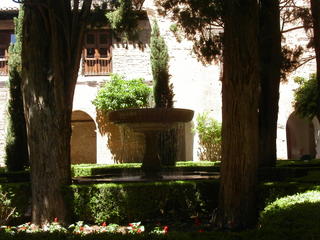 Gardens in the Palacio Nazaries.
Gardens in the Palacio Nazaries. View of the Gardens in the Palacio Nazaries from inside the palace.
View of the Gardens in the Palacio Nazaries from inside the palace.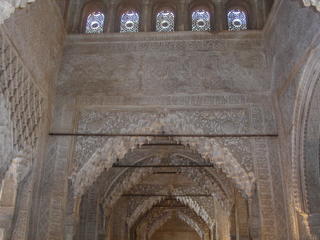 Throughtout the Palace you can see the elaborate work adorning the walls and ceilings.
Throughtout the Palace you can see the elaborate work adorning the walls and ceilings.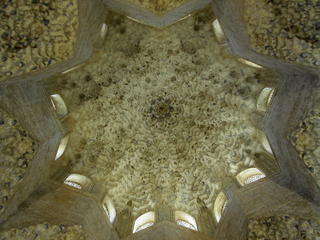 The dome of the Hall of the Abencerrages. The "Hall of Abencerrages" is a room which is a perfect square crowned with a high dome containing latticed windows in its lowest part. The roof is painted with bright blue, brown and gold and the columns supporting it spring out into the arch form in an exquisite manner. Opposite to it is the hall of "Two Sisters" which contains a fountain in the centre.
The dome of the Hall of the Abencerrages. The "Hall of Abencerrages" is a room which is a perfect square crowned with a high dome containing latticed windows in its lowest part. The roof is painted with bright blue, brown and gold and the columns supporting it spring out into the arch form in an exquisite manner. Opposite to it is the hall of "Two Sisters" which contains a fountain in the centre.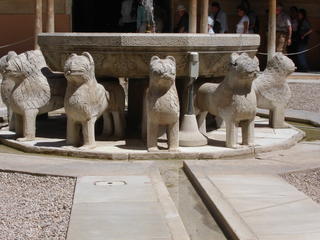 The Patio de los Leones (Court of the Lions). At its center is Andalusia's finest fountain, which rests on 12 marble lions.
The Patio de los Leones (Court of the Lions). At its center is Andalusia's finest fountain, which rests on 12 marble lions.  The greatest architectural achievement of the Alhambra is the Patio de los Leonares (Court of Lions). The patio was constructed by Muhammad V. This courtyard is lined with arcades supported by 124 slender marble columns.
The greatest architectural achievement of the Alhambra is the Patio de los Leonares (Court of Lions). The patio was constructed by Muhammad V. This courtyard is lined with arcades supported by 124 slender marble columns.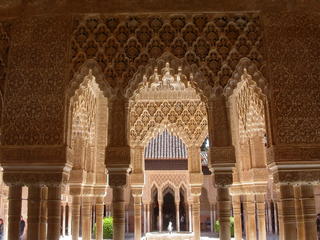 This was the heart of the palace, the most private section where the sultan enjoyed his harem, which included both male and female beauties.
This was the heart of the palace, the most private section where the sultan enjoyed his harem, which included both male and female beauties.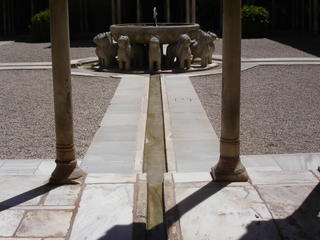 The twelve marble lions supporting the fountain represent the hours of the day, the months of the year, and the signs of the zodiac. Legend claims that water flowed from the mouth of a different lion each hour of the day.
The twelve marble lions supporting the fountain represent the hours of the day, the months of the year, and the signs of the zodiac. Legend claims that water flowed from the mouth of a different lion each hour of the day.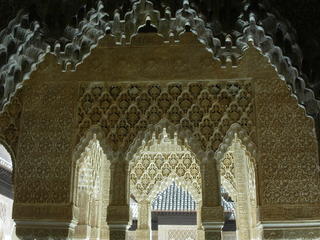 The walls and ceilings are decorated with geometric ornamentation of minute detail and intricacy, executed with surpassing skill in marble, alabaster, glazed tile, and carved plaster.
The walls and ceilings are decorated with geometric ornamentation of minute detail and intricacy, executed with surpassing skill in marble, alabaster, glazed tile, and carved plaster.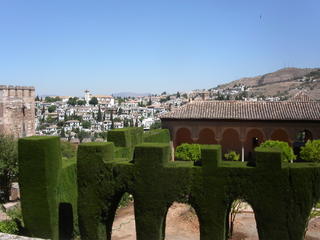
 "Give him alms woman because there is nothing as bad as being blind in Granada."
"Give him alms woman because there is nothing as bad as being blind in Granada."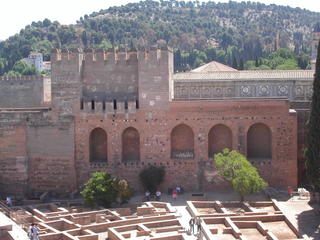 The city of the Alhambra - medina al-Hamrat - was excavated in the 19th century, revealing the foundations of luxury homes, some of which had their own baths.
The city of the Alhambra - medina al-Hamrat - was excavated in the 19th century, revealing the foundations of luxury homes, some of which had their own baths.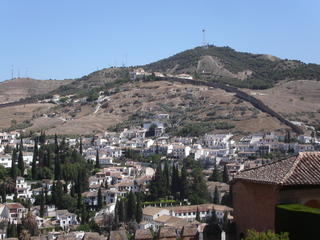 View of the the outer wall of the Alhambra and part of the Albaicin neighborhood. The residential district of the Albaicín is a rich repository of Moorish vernacular architecture, into which the traditional Andalusian architecture blends harmoniously.
View of the the outer wall of the Alhambra and part of the Albaicin neighborhood. The residential district of the Albaicín is a rich repository of Moorish vernacular architecture, into which the traditional Andalusian architecture blends harmoniously.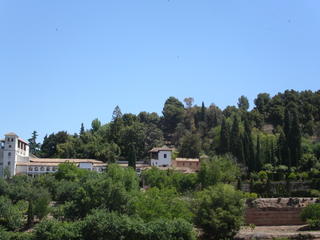 The Generalife (pronounced "heh-neh-rah-lee-feh") was the country estate of the King of Granada, and it was built in the 13th century. Located only a walk away from the main residence, it is located just outside the northern fortifications of the Alhambra. It’s thought that the name of the Generalife is derived from the Arabic for ‘the garden of the Architect’ alluding to God.
The Generalife (pronounced "heh-neh-rah-lee-feh") was the country estate of the King of Granada, and it was built in the 13th century. Located only a walk away from the main residence, it is located just outside the northern fortifications of the Alhambra. It’s thought that the name of the Generalife is derived from the Arabic for ‘the garden of the Architect’ alluding to God.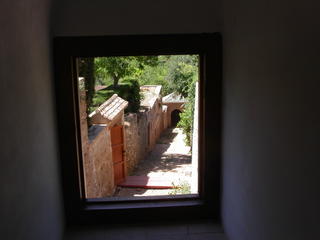 The Generalife was always meant to be a retreat, even from the splendors of the Alhambra. The sultans used to spend their summers in this palace safely locked away with their harems.
The Generalife was always meant to be a retreat, even from the splendors of the Alhambra. The sultans used to spend their summers in this palace safely locked away with their harems. The Generalife was built to overlook the Alhambra. The highlight of the Generalife is its gardens that include Escalera del Agua (The Water Staircase), El Patio de la Sultana, and El Patio de la Acequía, constructed around a long pool, with rows of water jets making graceful arches above it.
The Generalife was built to overlook the Alhambra. The highlight of the Generalife is its gardens that include Escalera del Agua (The Water Staircase), El Patio de la Sultana, and El Patio de la Acequía, constructed around a long pool, with rows of water jets making graceful arches above it.
"According to the leyend, this is the cypress that witnessed the rendezvous of an Abencerraje gentleman and the wife of Boabdil."
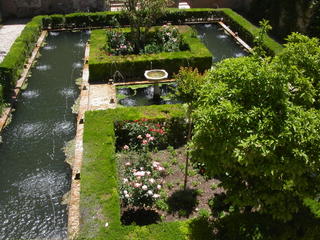
El Patio de la Sultana (also called the Patio de los Cipreses) was the secret rendezvous point for Zoraxda, wife of Sultan Abu Hasan, and her lover, the chief of the Abencarrajes.
No comments:
Post a Comment